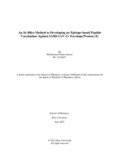An in silico Method to developing an epitope-based peptide vaccination against SARS-CoV-2's Envelope Protein (E)

View/
Date
2022-06Publisher
Brac UniversityAuthor
Intesar, Mohammad NafeesMetadata
Show full item recordAbstract
The new coronavirus (SARS-CoV-2) pandemic, which has killed millions of people throughout
the world, has afflicted millions of people. SARS-CoV-2 therapies were severely limited due to
the virus's quick pathogenicity. As a result, immunizations were desperately needed because there
were no effective medical therapies. Immunoinformatic approaches were employed in this work
to develop a multi-epitope vaccine that has the potential to activate the body’s immune system
against SARS-CoV-2. The viral structural protein was screened for the first group of epitopes.
VaxiJen v2.0, AllerTOP v2.0, and ToxinPred were used to identify probable antigenic, non-toxic,
and non-allergenic T-cell and B-cell epitopes, and a projected model was developed. IFNepitope,
IL4pred, and IL10pred were used to test cytokine inducing epitopes. One MHC I binding cytotoxic
T lymphocyte (CTL) (9-mer) and one MHC II binding helper T lymphocyte (HTL) (9-mer) were
tested for T-cell, as both have significant binding affinity and are antigenic, with scores of 0.7476
and 0.5993, respectively. Interferon-gamma, interleukin-4, and interleukin-10 were all induced by
the HTL epitope. The chosen B-cell epitope was non-toxic and non-allergenic, with a length of 15
and an antigen score of 0.4992. Epitopes were connected together using appropriate linkers, and
biochemical analysis in PROTPARAM revealed the vaccine's instability index (44.39) and
GRAVY (-0.023). Through homology modeling, the Phyre2 server projected a PDB model of the
final vaccination, which had 100 percent confidence and 47 percent coverage. The z-score (-4.75)
was used to determine the overall quality of the model using ProSA online. Patchdock achieved a
molecular docking score of 16070 in a 2366.10 square angstrom region by combining
complementing form concepts. The C-IMMSIM server was used to examine the proposed
vaccine's immunogenic profile. Immune responses, whether tertiary, secondary, or primary, all
played a part in vaccination immunity.
